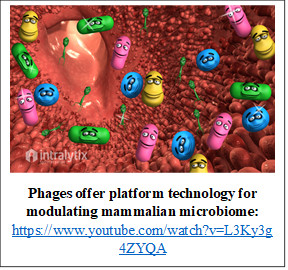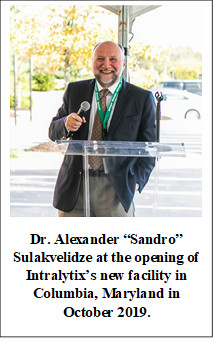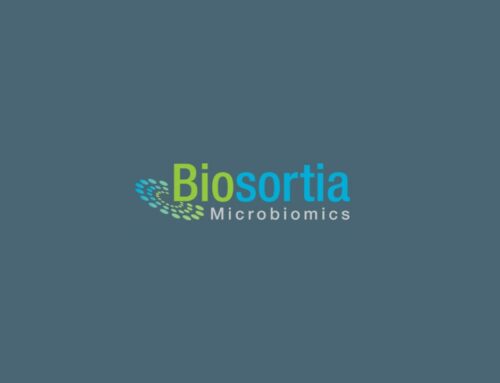– Interview with Alexander “Sandro” Sulakvelidze, President and CEO of Intralytix, Inc.
Bacteriophages, or shortly called just “phages,” are bacterial viruses and the most numerous living organisms on our planet. Their name literally means “bacteria-eaters” (combined from the words “bacteria” and Greek “phagein”- “to eat” or “to devour”). As the name implies, phages can effectively kill bacteria. Paradoxically, they are not widely used as human or animal therapeutics, largely due to the massive use of antibiotics (particularly in western countries). However, as we are facing global increase in antibiotic-resistant bacteria, use of bacteriophages is becoming a promising alternative.
Today, we are very honored and privileged to welcome Dr. Alexander “Sandro” Sulakvelidze. Sandro is the co-founder and President & CEO of Intralytix, a US-based company founded in 1998, dedicated to the use of the bacteriophage technologies. Intralytix was the first company in the world to receive FDA approval for commercial use of phages for food safety and is also pioneering applications of phages for human and animal therapy, environmental sanitation and in the field of microbiome.
Vladimir: “Dr. Sulakvelidze, I liked a lot your recent talk at the Great Copenhagen Microbiome Summit and since than I have checked all your podcasts (laugh)… Maybe you can start by telling us few words about yourself shortly and how your company started?”
Sandro: “It sounds like you´ve done a fair amount of research, so you may know some of what I am going to say now, in which case pardon for repetition…I was born and grew up in the former Soviet Union, in the country called Georgia. The famous Eliava Institute of Bacteriophage is in Georgia, and it was one of the main centers of the bacteriophage research in the Soviet Union and in the Eastern Europe. They have been producing, manufacturing and developing phage preparations for the phage therapy since 1923, when the Institute was founded by Felix d´Herelle and George Eliava.* I was exposed to bacteriophages since I was a child, I have taken them one time or another, just like my friends and almost anybody I know did. I have never given a second thought to it, just like you don´t think much about antibiotics. When you get sick, they are there, and you use them. I thought phages were also available everywhere around the world. In 1993, I received a fellowship from the US National Academy of Sciences to come to the University of Maryland Medical School to do my postdoctoral training. I came to the US and worked on infectious diseases, mostly diarrhea-causing bacterial infections. The person who brought me to the US was Prof. Glenn Morris, one of the most well-known infectious disease specialists in the world and a true visionary. We became friends, and our friendship continues to this day. Back then, Glenn was a professor at the University of Maryland Medical School, and I was working under his supervision, in his laboratory. He was also a practicing physician. One day I noticed Glenn was in a very bad mood. I asked what was going on and he explained that his patient underwent a very sophisticated surgical procedure, which itself went very well but afterwards the patient contracted an infection with vancomycin-resistant enterococci or VRE. Glenn and his colleagues had been trying everything to treat him but the infection causing bacterial strain turned out to be resistant to all commonly available antibiotics and the patient died. I asked: “how come that the bacteriophages did not get rid of the infection?” – because I knew that phages could kill bacteria even if they could not be killed by antibiotics. Glenn looked at me with puzzlement on his face – and I realized that he, one of the most knowledgeable infectious disease specialists in the world, did not know about the therapeutic use of bacteriophages and how they could be used to treat infections like those in the patient who just passed away from the VRE bacteremia. And Glenn was not alone – I quickly learned that almost no-one in this country knew about this therapeutic approach! This was one of the staggering moments in my life that really hit me – somebody´s father, brother, husband, friend, just died in one of the most developed countries in the world, after undergoing one of the most sophisticated surgical procedures – simply because of the infection that could be probably easily treated in Georgia, a developing country that I just came from. It just did not make sense… That “makes no sense” sentiment led to some brainstorming, and we ended up founding Intralytix in June of 1998. Our initial goal was to pursue human therapeutic applications. However, we quickly realized that this idea, although fairly common in the Soviet Union and some Eastern European countries, was so unorthodox in the United States that we just could not make it work. There were no regulations, nobody knew how to approve anything like this, no infrastructure, intellectual protection unclear, investors reluctant to put money up, and so on. So after some soul searching, we decided to shift the initial focus of the company to the agricultural application. We were the first company in the world to receive the FDA approval for a phage-based product for the food safety applications. It took us more than four years to get it approved because we didn´t know how to do it, FDA didn´t know what to ask for since this was first time for them too. But we learned and we created a roadmap for us and probably for every other phage company in the field. Subsequent approvals took a lot less time, and we now have the largest portfolio in the world of FDA- and USDA-approved phage products on the market, for food safety applications, with sales steadily increasing. And we are now expanding into other areas, where our phage technology could be useful.
Vladimir: “Great story! We are witnessing a rapid growth in microbiome-related publications, grants and investments. Many entrepreneurs are stepping into the field and similar trends we observe in the bacteriophage technologies, there are more and more companies coming…Could you shortly elaborate on current developments in the bacteriophage field, especially regarding the microbiome and how do you see the future applications?”
Sandro: “Starting from our first FDA approval to the largest number of commercial phage products on the market, largest phage-biocontrol and phage-therapy focused patent portfolio,  largest manufacturing capabilities for phages in the world and so on, Intralytix has been truly a forerunner in the field. And one of the most exciting things that we also pioneered is the microbiome application of bacteriophages – when phages are used to targetedly remove problem bacteria in microbiome, thus fine-tuning it for various health benefits. We even have two issued patents for this concept. Most phage companies focus on the therapy of human bacterial infections. We looked ahead understanding that the microbiomes play a significant role in almost every system. When people hear the word “microbiome”, they usually think about gastrointestinal tract but there is vaginal microbiome, skin microbiome, oral cavity microbiome, environmental microbiome…it´s everywhere. There are hundreds of millions of dollars going into microbiome research these days, lots of academic groups are involved, and so are many companies. People are studying microbiomes exhaustively and links are being established between certain microbiome compositions and various diseases and, what is most intriguing to me, is that some of these diseases are not infectious. For example, links have been proposed between certain microbiome compositions and such noninfectious diseases as are obesity, certain forms of cancers, mental health, or even our moods. As the science of microbiome evolves, some of these hypotheses are almost guaranteed to be proven futile but some of them will be confirmed. And we will need tools to take advantage of this knowledge and to gently modulate the microbiome, to fine tune it, to enhance it. There is no doubt that there will be various approaches for this, and bacteriophages are one of such approaches, perhaps the most direct and natural. If we can find an appropriate phage and use it in a proper way to fine tune a microbiome, for example by taking out or reducing the levels of certain “problem” bacteria or phyla in the microbiome while promoting the growth of the beneficial microorganisms, we can potentially yield many health benefits. And we are not talking about just preventing or treating diarrhea – classical use of phages in many countries – but something much more complex and far reaching…Just think
largest manufacturing capabilities for phages in the world and so on, Intralytix has been truly a forerunner in the field. And one of the most exciting things that we also pioneered is the microbiome application of bacteriophages – when phages are used to targetedly remove problem bacteria in microbiome, thus fine-tuning it for various health benefits. We even have two issued patents for this concept. Most phage companies focus on the therapy of human bacterial infections. We looked ahead understanding that the microbiomes play a significant role in almost every system. When people hear the word “microbiome”, they usually think about gastrointestinal tract but there is vaginal microbiome, skin microbiome, oral cavity microbiome, environmental microbiome…it´s everywhere. There are hundreds of millions of dollars going into microbiome research these days, lots of academic groups are involved, and so are many companies. People are studying microbiomes exhaustively and links are being established between certain microbiome compositions and various diseases and, what is most intriguing to me, is that some of these diseases are not infectious. For example, links have been proposed between certain microbiome compositions and such noninfectious diseases as are obesity, certain forms of cancers, mental health, or even our moods. As the science of microbiome evolves, some of these hypotheses are almost guaranteed to be proven futile but some of them will be confirmed. And we will need tools to take advantage of this knowledge and to gently modulate the microbiome, to fine tune it, to enhance it. There is no doubt that there will be various approaches for this, and bacteriophages are one of such approaches, perhaps the most direct and natural. If we can find an appropriate phage and use it in a proper way to fine tune a microbiome, for example by taking out or reducing the levels of certain “problem” bacteria or phyla in the microbiome while promoting the growth of the beneficial microorganisms, we can potentially yield many health benefits. And we are not talking about just preventing or treating diarrhea – classical use of phages in many countries – but something much more complex and far reaching…Just think
about the implications and potential health benefits, and how far this can go!
Vladimir: “Modulation of which microbiomes: gut, skin or others?”
Sandro: Any. Including skin and gut. For the latter, we will be launching our first “microbiome modulating” nutraceutical product this year. It will be for enhancing gut microbiome with natural bacteriophages against traditional diarrhea-causing bacteria such as E. coli, Salmonella, and Listeria monocytogenes. We will launch our 2nd nutraceutical product next year, and many more to follow. We continue to enhance and invest in our infrastructure, manufacturing capabilities, and the science, so that we can offer our customers a broad choice of phage products for various microbiome applications.
Vladimir: “I´ve read that you combine probiotics with bacteriophages to create new products. Is this similar to the new product you mentioned?”
Sandro: “No. Our first product will be phages only. It will be a cocktail of fifteen different bacteriophages that target three major foodborne pathogens: the Shiga-toxin producing E. coli (including E. coli O157:H7), Salmonella, and Listeria monocytogenes. This preparation, tentatively called FOP (for Foodborne Outbreak Pill) has already been shown by various industry and academic groups – with several peer reviewed scientific publications available – to be very effective in managing detrimental effects of these bacterial pathogens on our microbiome and overall health. Our second product also will be phages only. We call these types of microbiome-modulating phage products and the approach itself Phagebiotix. We are also working on products that would include both phages and traditional bacteria- and/or yeast-based probiotics, for enhanced and broader efficacy. We call such combinational products – and the approach – Superbiotix, and the first such product is expected to be launched in about 12-24 months from now.
Vladimir: “Superbiotics! (laugh)…nice name, I have to remember that” (both laugh). Have you also thought about some applications in plants? There have been lot of investments in this sector, especially in the US…
Sandro: We have thought about plant applications, but we do not have any crop-protection products. There are so many potential applications for our phage technology, and you have to  really think hard which to pursue and in what order, as you cannot do all at once. Market is a big driving force in the selection process, but also your beliefs where this technology will work the best. So, we will likely develop some plant protection products in the future, but we do not have them just yet.
really think hard which to pursue and in what order, as you cannot do all at once. Market is a big driving force in the selection process, but also your beliefs where this technology will work the best. So, we will likely develop some plant protection products in the future, but we do not have them just yet.
Vladimir: “Sounds fantastic! As with any new technology, safety is an issue. How about the phage resistance?
Sandro: “Resistance against phages will develop eventually, no doubt. Bacteria mutate naturally and at some point, there will be a bacterial strain or strains resistant to the phages that are in our phage cocktails today. It´s a biological arms race that has been going on for billions of years. Bacteria and phages constantly co-evolve. But there are certain steps that we use to reduce the frequency of resistance emerging rapidly against our products. One of the things we do for that is that we only use phage cocktails. We design those cocktails so that one bacterial strain is killed by two or more phages whenever possible, ideally attaching to different receptors on the bacterial membrane, so that one “resistance” mutation against one phage is not rendering other phages ineffective. Other consideration, perhaps even more important, is the design of intervention strategy. For instance, if you start spraying a chicken house with phages, the resistance is likely to emerge fairly quickly because it is a very complex environment. On the other hand, if you spray food with phages right before those foods get packaged and shipped, the exposure is limited to that package and there is no broad selection pressure that grants bacteria evolutionary advantages to become phage resistant. Ultimately the resistance will happen, and the strategy is to update your phage cocktail to be able to cope with the trend of new bacterial clones emerging. There are two challenges to that: one is technical – you need to constantly monitor the bacterial population and their sensitivity against phages, and you need to be able to isolate new phages and have them ready in case you need to substitute. In addition, there is also a regulatory aspect, to ensure that you do not need to get new regulatory approvals for every phage substitution you make in your product – as regulatory approvals are typically lengthy. Fortunately, the FDA seems to be agreeable with this concept and granted us such flexibility. Such phage substitutions and cocktail updates are subject to certain conditions of course. For example, each new phage should be a lytic phage and must meet the same safety criteria as the original phages in your cocktail. Also, each cocktail should be produced using manufacturing protocols that guarantee its purity just like your original cocktail. But these are reasonable and common-sense requirements, and my hope is that FDA will be implementing such policy for all phage preparations, not just for food safety applications but for other applications as well, including human therapy”
Vladimir: “We have seen recently the development of the phages based on the gene-editing technologies such as CRISPR. How do you see that?”
Sandro: “It´s an exciting science. The concept of using molecular biology tools to take a relatively simple biological entity like phage and engineer it to be better or stronger is intellectually exciting. Thus, many scientists – especially basic science researchers – like it. It is also an easier sell to investors, as the perception is that such engineered phages are better than natural phages and they are also easier to patent. I think this is one of the reasons why some companies are pursuing this approach: one, they can attract investments and have better IP protection and, two, they think engineered phages might be better than the wild type phages. On the first point I agree but I´m not so certain about the second. For example, over the years, several investigators sent me their engineered phages, I compared them with our phage cocktails and cocktails were always better. I believe that Mother Nature has the best genetic engineering laboratory… So, I am not brushing off the idea completely, it is a good science, and it may at some point result in a good product, but it is not the way we chose. We like the concept that our products are all natural and not genetically modified. It´s a bit philosophical but also a corporate decision to pursue natural products.
Vladimir: “Many people would like to see phage applications as soon as possible. In Europe, for example, there are very few countries where you can use bacteriophages for therapy. Recently I´ve read a crazy story about a woman from Germany travelling to Belgium to pick up her phage therapy which she orders from Georgia. We have also thousands of people yearly affected by food poisoning. Many people in Germany remember enteropathogenic E. coli outbreak in 2011 with more than fifty deaths. What would be your advice, how to speed up the regulatory procedures for phages in Europe?”
Sandro: “Our Company does not have any approved phage products for Europe yet. We have approvals for food safety phage products in the US, Canada, and Israel. I heard that in Europe it is more difficult to gain such approvals for phage applications, and that is really puzzling me as I cannot imagine what is the scientific justification from the European regulators not to green light this approach. Phages are naturally present in all fresh unprocessed foods, and people eat them all the time. Also, our gut microbiome naturally contains about 10^15 phages…. So, I am not sure why we cannot apply natural phages (which often came from the foods in the first place) to improve food safety? It seems like a logical approach to me, and I feel it is much better to have a bit extra phage in the foods than to have Salmonella or pathogenic E. coli in them…. Hopefully, European regulators will also allow phage biocontrol applications soon.
Vladimir: “I completely agree. What do you think about phage products such as lysins, instead of living phages?
Sandro: “Lysins may or may not work well against Gram-negative bacteria, may not be sufficiently stable – at least in formulations suitable for food safety applications – and may be too expensive to produce (certainly more expensive than phages). Food safety is a very thin-margin business. If your food safety intervention costs more than few cents per pound on an ongoing basis, you may as well forget it. Once you start getting into genetic engineering and recombinant production, you may not be able to deliver an attractive value proposition to your customers in the food industry. On the other hand, lysins might be attractive for some other applications, such as cosmetic or oral care, especially against Gram-positive bacteria.”
Vladimir: “What would be your advice or message to the entrepreneurs or companies starting in the field and how to boost collaborations?”
Sandro: “First, and obviously, you should have something to offer – so make sure your technology and ideas are intriguing while also making business sense – and be able to present them properly, in a concise and focused manner. Secondly, be pragmatic and realistic. I will give you an example…We recently worked with one  academic group in South America. We evaluated their phages and wanted to license or purchase some of their phages for subsequent development and commercialization. They asked for 4.6 million dollars for 3 or 4 bacteriophages – which was obviously a no go. We have since found similar phages elsewhere, but I suspect they are still waiting for someone to pay them $4.6M. So be realistic in your business and when dealing with potential investors and partners. Third, be persistent and not afraid of a failure. If one company or investor rejected you, go to the second, go to the third. If your technology is good and you are honest and realistic in your approach, you will find partners and support. Just do not give up.
academic group in South America. We evaluated their phages and wanted to license or purchase some of their phages for subsequent development and commercialization. They asked for 4.6 million dollars for 3 or 4 bacteriophages – which was obviously a no go. We have since found similar phages elsewhere, but I suspect they are still waiting for someone to pay them $4.6M. So be realistic in your business and when dealing with potential investors and partners. Third, be persistent and not afraid of a failure. If one company or investor rejected you, go to the second, go to the third. If your technology is good and you are honest and realistic in your approach, you will find partners and support. Just do not give up.
* The institute in Tbilisi, Georgia is nowadays called “George Eliava Institute”. Felix d´Herelle (1873-1949) was a French microbiologist famous as a discoverer of the bacteriophages in 1917. George Eliava (1892-1937) was a Georgian-Soviet microbiologist who pioneered phage therapy in the Soviet Union.



